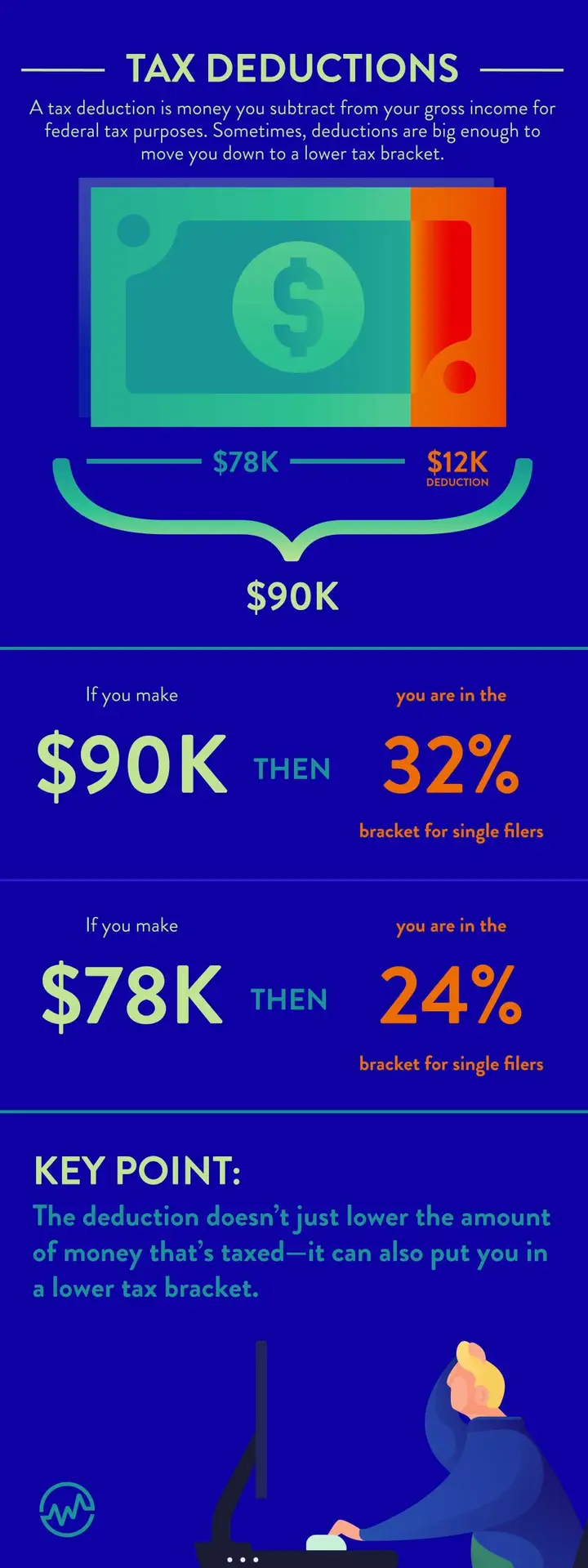How do tax write-offs work?
You’ve probably heard someone say “it’s a tax write-off” right before buying something expensive, like a new computer, new desk, or new office supplies.
Unfortunately, tax write-offs aren’t so simple.
It takes a lot of planning and accounting to make write-offs worth it.
So how do tax write-offs work?
Learning how tax write-offs work can help you make better purchase decisions and pay lxxess taxes.
When people throw around the term “write-off” it means either a tax deduction or tax credit. These have different effects on your tax bill. It’s important to know which ones you’re eligible for and the difference between the two, because knowing “how do tax write-offs work” can save you a significant amount of money in the long run.
In this tax strategy article, we will explain:
- Answers to the question “how do tax write-offs work”
- The difference between a tax deduction and a tax credit — and tax credits you can take advantage of
- The difference between ordinary and necessary expenses
- Small business tax deductions that will help you save money
Let’s get started!
What are Tax Write Offs?
A tax write off is an expense that can later be deducted from your overall taxable income or claimed as a tax credit.
For instance, let’s say that you own a small business and need a website to market your services.
A website won’t come cheap, and there are specific expenses associated with the cost of getting it live.
To help small businesses cope with the expenses of running their operations, certain expenditures, like marketing and advertising, can be deducted from their overall taxable income.
So, when you go to file your taxes, you can subtract your website expenses from your overall taxable income amount.
Doing so could help you remain in a lower tax bracket — and face overall lower taxes.
Business owners aren’t the only category of taxpayers that can use write-offs, though.
Individuals, corporations, and even self-employed freelancers can write-off expenses, too.
Interest payments on student loans or charitable donations, for instance, are also considered tax write-offs.
We’ll go into more detail about the most common types of tax write-offs leveraged by taxpayers later on in the article.
Advantages of Tax Write Offs
The most obvious advantage of utilizing tax write offs is that it reduces your overall tax burden.
How so?
When you utilize a tax write off, the expense is completely deducted from your overall gross income amount.
For instance, let’s say you made $10,000 in 2020 but $1,000 was spent on start-up costs.
You would literally subtract the deduction from your income ($10,000-$1,000 = $9,000), which would reduce your taxable income by a huge chunk.
This ultimately leads to a lower tax bill and reduced tax burden.
Disadvantages of Tax Write Offs
Tax write offs do have some disadvantages as well.
If you take advantage of the standard tax deduction, then you could be missing out on savings with certain tax write offs you could make.
You won’t be able to file for both the standard deduction and itemized deductions, though.
So, it will take you a lot of time and effort to determine which method will be the most lucrative for you or your business.
What Are Tax Deductions?
When asking how do tax write offs work, some of the answer lies in understanding what a tax deduction is.
This starts with your gross income. It’s the total amount of money you make in a year, from all different sources, including your job, side income, and any investments.
Here in the United States, we have a graduated tax system. The percentage of income the federal government takes in taxes increases as your gross income increases.
A tax deduction is money you subtract from your gross income for federal tax purposes. Sometimes, deductions are big enough to move you down to a lower tax bracket.
Most Americans, even those who own small businesses, tend to take the standard tax deduction when they file taxes.
For 2022, that standard tax deduction amounts to $12,950 for single filers and $25,900 for married couples.
The standard deduction is the amount that the Internal Revenue Service (IRS) allows every person filing taxes deduct from their gross income before determining your tax rate.

Standard Deduction
If you’re a single person with a salary of $90,000, you subtract the standard deduction of $12,000 and that makes your adjusted gross income $78,000. You will only pay taxes on the $78,000.
If you make $90,000, you are in the 32% bracket for single filers. If your adjusted gross income is $78,000, then you are in the 24% bracket for single filers.
Here’s the key point: the deduction doesn’t just lower the amount of money that’s taxed — it can also put you in a lower tax bracket.
That’s why tax write-offs can really benefit you.
When someone asks “how do tax write-offs work”, that’s the concise way to explain it.
But you can’t take both the standard deduction and the different write-offs. You have to choose between one or the other.
Itemizing
The tax write-offs that are deductions are beneficial if you decide to itemize your deductions. Itemizing means you add up many deductions specific to your business.
Again, if you do this, you can’t take the standard deduction.
If you have business write-offs that add up to $20,000, you could take those instead of the standard deduction of $12,000.
If your income is $90,000 and you deduct $20,000, your adjusted gross income is $70,000. Assuming a 24% tax rate, your tax bill is 24% of $70,000 — $16,800.
If you had taken the standard deduction, your tax bill would have been 24% of $78,000, or $18,720. In this example, itemizing the deductions saves you $1,920.
If you don’t itemize, the deductions you can take for business expenses are moot. Luckily for business owners, there are many deductions available to make itemizing worthwhile.
What Are Tax Credits?

Unlike a deduction, a tax credit is a dollar-for-dollar refund.
If your income is $90,000 with a tax rate of 32%, your tax bill is $28,880—but a $20,000 credit reduces it to $8,800.
You might think credits are better based on that example. But the truth is that $20,000 credit may not exist. While plenty of deductions are worth that much, most credits are worth a couple thousand at most.
One thing to remember when answering the question of how do tax write offs work: all write-offs are not created equal. Credits are worth more to lower-income earners and phase out as your income increases, while deductions are mostly available to anyone who can properly claim them.
The most popular credits are:
- child tax credit
- earned income tax credit
- dependent care tax credit
- lifetime learning credit
- american opportunity tax credit
- student loan interest deduction
- home office deduction
- residential energy credit
Neither of these credits are specific to business owners.
There are tax credits for:
- developing a new patent or software
- spending money to make your office accessible for those with disabilities
- using alternative fuel
- providing benefits like health insurance or paid family leave to employees
These don’t phase out as quickly as the basic ones.
But if you’re in the majority of freelancers or entrepreneurs, these don’t apply to you. Most, if not all of your write-offs, will be deductions.
So how do tax write offs work for most small business owners?
You combine the write-offs available for you as an individual with those available for you as a professional to reap the highest rewards.
What are Ordinary and Necessary Expenses?

What kind of business expenses count as tax deductions? The IRS says that an expense must be both “ordinary” and “necessary” to be deductible.
How are those terms defined?
An ordinary expense is normal for your industry.
A necessary expense is “helpful and appropriate” for your industry.
This means an expense has to be directly related to your business and essential to running it.
For example, the web hosting fees for maintaining your company’s website are both ordinary and necessary. Whatever your industry, you need an online presence in today’s digital era to advertise and connect with clients. Well-maintained websites aren’t free.
Industry practices matter. If you run a kayak school, the kayaks you purchase for children to learn in are both ordinary (all kayak schools need equipment) and necessary (you can’t learn to kayak without being in one).
But if you’re a lawyer and you buy a kayak to “take clients out” it doesn’t count, because you don’t need a kayak to practice law. Make sense?
Likewise, a private chef uses a fancy blender to make food for her clients, but an accountant who buys the same blender to make smoothies for the waiting area doesn’t have that justification.
There’s no hard and fast list covering every industry, but the IRS does tend to audit small business owners who claim interesting deductions, so playing by the rules is strongly advised.
Popular Small Business Tax Deductions
There are, however, some popular deductions that apply to business owners across many different industries. Let’s look at 10 of them to help answer the question “how do tax write-offs work?”
Self-Employment Taxes
Business owners subject to paying self-employment taxes (“SECA”) can deduct the employer-equivalent portion on their income tax return.
SECA taxes cover Social Security and Medicare contributions. The rate is 15.3%. This includes 12.4% for social security and 2.9% for Medicare.
If you would owe at least $1,000 in taxes on your freelance income for the year, you should be paying SECA taxes every quarter. Be sure to check.
Startup Costs
You can deduct up to $5,000 in costs incurred in creating or acquiring an “active trade or business” although higher startup costs end up going on your tax return for years to follow.
These costs could include:
- purchasing a domain name for your company website
- advertising on Facebook and Google or in the local paper
- paying the fees to incorporate or set up an LLC in your state
If you are going to incur a lot of startup costs, it is important to thoroughly consult IRS Publication 535 to understand some of the special rules applied to different kinds of startup costs and very large amounts.
Business Supplies and Postage
If you print anything for your business, the cost of the paper and ink count as tax deductions. If you mail what you printed, so does the cost of the postage.
Meals
You can deduct meals up to 50% if the expenses are solely for business purposes.
Car
You can deduct the portion of expenses from using your car for business.
You can do this one of two ways:
Standard Mileage Rate
This is found by multiplying the amount of miles you have driven for your business by what’s called the “standard mileage rate”.
For example, the standard mileage deduction in 2020 was $0.57½ per mile, and in 2021, is $0.56 per mile.
Actual Expense Method
For this method, it’s critical to track all of the costs of the vehicle each year (such as gas, repairs, insurance, and more).
You then multiply these expenses by the percentage of miles you have driven.
Travel Expenses
If you fly on a plane, stay overnight in a hotel, or eat a meal on a business trip, these expenses are deductions. The IRS is strict about what counts.
Your Office
You can write off the cost of your home office if it is your principal place of business. This means it’s the place you work every day.
If you have an office space nearby that you work out of and use the home office on other days, the home office does not qualify as a deduction.
But you can deduct the rent on your other office space. You cannot deduct both.
If your home office qualifies, you can deduct costs for:
- mortgage interest
- utilities (internet connection, cellphone electricity, water)
- Repairs for the percentage of your home occupied by the office
For example, if you live in a 1,500 square foot house and use one 300 square foot bedroom as your office, you can deduct 20% of those expenses.
Routine repairs to your office space are also deductible, but big improvements are treated differently.
If you’re deducting expenses for a rented office instead of your home, the same rules applies for things like utilities and repairs.
Insurance
The costs of an owner’s policy, malpractice coverage, and health insurance for you and your spouse and dependents, are all deductible.
Legal and Accounting Fees
If they’re for your business, they’re deductible (you cannot write off your divorce lawyer’s fees as a business expense, even if the stress of getting divorced is hurting your business).
State and Local Taxes
These properly attributed as a business expense are deductible on your federal tax return.
Freelancing
If you have a pass-through business or are a sole proprietor like most freelancers, you can deduct up to 20% of your business income on your personal tax return.
This is a new deduction created by the late 2017 tax law.
A “pass-through” business is a business where the owner puts all of the income on his or her individual tax return and the business doesn’t file its own tax return. LLCs are pass-through businesses.
If your business generates $50,000 of profits in 2019, you can deduct $10,000 on your return for the year.
This deduction alone puts many business owners over the hump for itemizing, rather than taking the standard deduction.
Bank Fees
The fees you pay to maintain your business checking account, to obtain new checks and more are deductible.
Business Education
Did you know that education costs are fully deductible if they add value to your business?
It’s true! Types of deductible business education include:
- Seminars and webinars
- Subscriptions to trade or professional publications, such as a magazine
- Industry books
- Workshops
- Transportation expenses to and from seminars and workshops
Other Popular Tax Deductions
When wondering “how do tax write offs work”, it’s important to keep in mind other popular tax deductions.
Another common type of tax deduction write-off is donations to charities.
If you make contributions to specific organizations, then you can also write that off as a tax deduction.
What’s more, any medical or dental expenses that cost you more than 7.5% of your AGI could get deducted as medical expenses as well.
With Tax Write Offs, Doing the Math Saves You Mon

If you do the math, adding up all of these deductions can put the total above the amount of the standard deduction, saving you money by decreasing the amount of taxable income. decreasing the amount of taxable income.
But remember, these write-offs do not give you money back dollar-for-dollar that you spent on a nicer office space or a new computer.
Does that mean you shouldn’t buy a new computer?
As always, the answer depends on what the computer is worth to your productivity and your business.
It’ll probably save you a few bucks on your taxes — just not enough to recoup the cost unless it also increases your efficiency, because it’s a deduction rather than a credit.
Keep that in mind when you’re incurring expenses for your business. This way you won’t be surprised with a large tax bill the following year.
“How Do Tax Write-Offs Work?”
Many Americans overpay in taxes each year.
But you don’t have to.
The most important item to understand with tax write-offs is that you have the ability to lower your tax bill — the tools are in this article — and you simply need to put in the time, research to understand how these tools apply to your business.
The result?
More money in your pocket that you can use to reinvest in your business and take it — and your career — to new heights.
Additional Tax Strategy Resources
The one thing that successful business owners and entrepreneurs have in common is that they view learning as a lifelong habit.
Now that you know the answers to the question “how do tax write offs-work”, learn additional ways to save money come tax time with these additional (and free!) resources:












